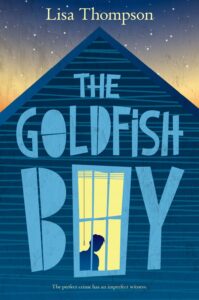 Review By: Anonymous
Review By: Anonymous
Published: 2018
Genre(s): Realistic Fiction, Mystery, Mental Health
Audience: Grades 3–7
Content Warnings: Obsessive-compulsive disorder (OCD), loss of a newborn, disappearance of a toddler, mild language (“damn”)
Goodreads Link: The Goldfish Boy
Summary:
Lisa Thompson’s debut novel is a page-turning mystery with an emotionally-driven, complex character study at its core — like Rear Window meets The Curious Incident of the Dog in the Night-Time.
Matthew Corbin suffers from severe obsessive-compulsive disorder. He hasn’t been to school in weeks. His hands are cracked and bleeding from cleaning. He refuses to leave his bedroom. To pass the time, he observes his neighbors from his bedroom window, making mundane notes about their habits as they bustle about the cul-de-sac.
When a toddler staying next door goes missing, it becomes apparent that Matthew was the last person to see him alive. Suddenly, Matthew finds himself at the center of a high-stakes mystery, and every one of his neighbors is a suspect. Matthew is the key to figuring out what happened and potentially saving a child’s life… but is he able to do so if it means exposing his own secrets, and stepping out from the safety of his home?
Review:
I recently read The Goldfish Boy by Lisa Thompson aloud to my fourth grade class, and while there were some strong moments, there are a few things I’d want other teachers to consider before choosing it as a classroom read.
The story centers around Matthew, a boy who struggles with obsessive-compulsive disorder (OCD) and rarely leaves his house. When a toddler from the neighborhood goes missing, Matthew—who observes everything from his window—gets pulled into the mystery. The plot also slowly reveals what happened to Matthew’s baby brother, which adds another layer of emotional depth.
My students were really interested in the mystery of the missing toddler. Trying to piece together what happened kept them engaged, especially during those more suspenseful chapters. They were also curious about Matthew’s past and why he behaves the way he does. It opened up opportunities for discussions about mental health, empathy, and grief in a way that was accessible and meaningful.
There are some lulls in the story where the pace slows down, and I noticed students losing interest during those parts. The writing includes many complex sentences and advanced vocabulary, which made it tough for some students to follow during read-aloud time. The content touches on themes like death, trauma, and anxiety. While it’s handled with care, it may be too heavy for some younger or more sensitive students without proper support or context.
The Goldfish Boy can be a powerful read, but I’d recommend it for upper elementary or as a small group/book club choice where you can pause for discussion. It’s best suited for students who can handle mature topics (mental health, death, etc.) and longer periods of slower plot development.



